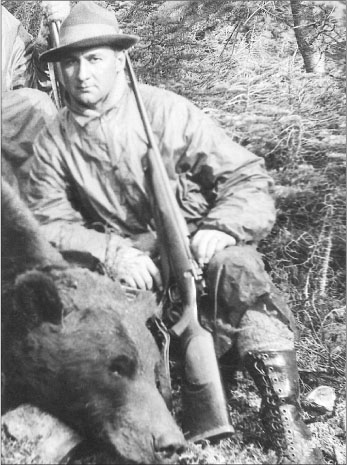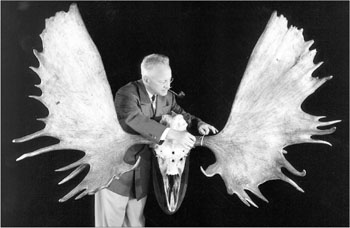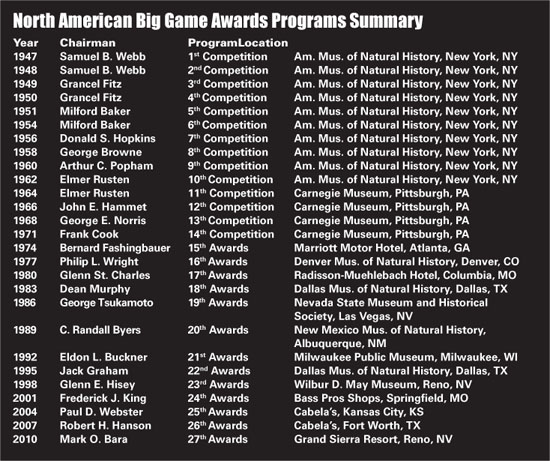
The Boone and Crockett Club was founded in 1887 by Theodore Roosevelt and a group of his close friends. The Club was established because of their mutual love of hunting and the native big game animals of North America. At that time, there were no closed hunting seasons or other regulations on the taking of game. But even this early, the Club and its members were foresighted and well ahead of current need. The concept of “Fair Chase” was introduced in the bylaws of the Club in the 1880s at a time when “hunting” was a 24/7, 365 days a year occupation that many enthusiastically participated in to make a living, clear their farms and ranches of competition, or simply feed themselves and their families. For example, the Club deemed it unfair chase to burn animals out of their dens and chase them down with snowshoes in deep snow. Because of the Club’s efforts to push fair chase, implement game laws and regulations, many big game animals were brought back from the verge of extinction.

During the days of his presidency, Theodore Roosevelt would gain well-justified recognition as our “Conservation President.” His contributions were legion. Under his administration, the following were created: 21 reclamation projects, 150 national forests, 51 federal bird reservations, four national game preserves, five national parks and 18 national monuments. A number of conservation conferences and commissions were also established. His reign in office set a firm foundation for today’s conservation and wildlife management in the United States.
The actual coining of the word conservation was by Gifford Pinchot, the far-sighted forester and Club member who was the first head of the U.S. Forest Service. Pinchot developed the word conservation to define the whole complex of actions necessary to properly manage our natural resources in good stewardship. As he defined it, it meant in the most simple terms, “wise use”. Conservation today should therefore mean full rational use of renewable resources (such as forests and wildlife) and the lowest rational usage of non-renewable resources (such as minerals, coal, and oil).
By the end of Roosevelt’s presidency, things were indeed looking bleak for many of the native big-game animals. Bison, whose numbers were once estimated in the tens of millions, were reduced to a few hundred head, and whitetails and other big game were largely eliminated from the states east of the Mississippi. Many folks believed there could be no other final result of civilization’s push West than the extinction of all big game. Even several prominent Club members such as William T. Hornaday and Madison Grant agreed with this dismal forecast. During the years of 1906-1922, Hornaday worked industriously to establish the National Collection of Heads and Horns at the Bronx Zoo in New York City. Opened in a large building in 1922, the collection was dedicated to “...the vanishing big-game animals of the world.” Today, the collection is the property of the Boone and Crockett Club and is, as of this writing, on display at the Buffalo Bill Historical Center, Cody, Wyoming. It includes many fine specimens such as the L.S. Chadwick Stone’s sheep, acclaimed by many as the finest specimen of North American big game ever taken. It is an outstanding collection that will give much enjoyment to the hunter and other serious students of our native North American big game. More importantly, today it represents the outstanding success stories of modern game management and conservation that have restored our game populations to healthy levels that can be utilized in consumptive uses such as hunting, as well as just the plain enjoyment of watching these magnificent creatures in the wild.
The presence of the National Collection and the beginning of conservation in the 1920s spurred interest in recording of measurements of our big game animals. In 1932, Prentiss N. Gray, a long-time Club member, authored the first big-game records book of the Club titled, Records of North American Big Game. It was published with the cooperation of the National Collection of Heads and Horns. The measurements were quite simple, the length of skull, or the longer antler or horn, plus a basal circumference. This volume was followed in 1939 by a second edition called North American Big Game. Again, simple measurements were used to rank the trophies listed. This edition is especially notable for several fine chapters on subjects related to measurement and big game. Grancel Fitz had a lengthy chapter on his idea of a complex system of measurements that would, as a result of the numeric score total, rank trophies naturally. This chapter furnished an excellent counterpoint to the rival system being used by Dr. James L. Clark, a noted taxidermist and long-time Club member, for his Big Game Competitions. Fitz’s system was a bit more objective, while Clark’s was more imaginative in its measurements. Both systems had serious flaws but were superior to the single measurement ranking used in the 1932 and 1939 records books of the Club.

The Second World War years occupied all of America fully. Following the war, as things began to return to normal, interest was renewed in the Boone and Crockett Club in big-game records keeping. In 1947, the Club began annual Big Game Competitions, with the winners being chosen by a Judges’ Panel. But, while these proved popular, they also pointed out the subjective nature of awards based entirely upon the opinions of a group of judges, no matter how well qualified. There was an obvious need for an objective system that could be applied by sportsmen to their own best trophies.
In 1949, Samuel B. Webb, well-known to major Club members and a close friend of both Grancel Fitz and Dr. James L. Clark, was chosen to chair a special committee of the Club to devise an equitable, objective measurement system for the big game of North America. In addition to Webb, Fitz, and Clark, the committee members included Dr. Harold E. Anthony, Milford Baker, and Frederick K. Barbour. All were experienced big game hunters with strong interest in giving recognition to exceptional big game trophies. The committee worked during the year to arrive at the system adopted by the Boone and Crockett Club in 1950. Prior to publication, the system was circulated to 250 sportsmen, biologists, and other interested parties for their comments. Once adopted, the system quickly became established as the universally accepted standard for measuring native North American big game.
That the committee was able to evolve a comprehensive system meshing the best points of both Fitz’s and Clark’s systems is a distinct tribute to the committee chair, Samuel B. Webb. Fitz and Clark were both very intelligent and accomplished men with full confidence that their own system was the best. Drawing on his friendships with both, Webb was able to focus the committee to arrive at the resulting system that combined the stronger points of both systems into a system so objective and fair that it continues today in essentially the same form as originally formulated.
The scoring system depends upon carefully taken measurements of the enduring trophy characteristics to arrive at a numerical final score that provides instant ranking for all trophies of a category. By measuring only enduring characters (such as antlers, horns, tusks, and skulls) rather than skin length or carcass weight, the measurements may be repeated at any later date to verify both the measurements and the resulting ranking in each category. Anyone doubting the correctness of a particular trophy’s ranking can readily prove or disprove his own contentions by a simple replication of the measurements.
The system places heavy emphasis on symmetry, penalizing those portions of the measured material that are non-symmetrical. This results in even, well-matched trophies scoring better and placing higher in the rankings than equally developed but mismatched trophies, a result that most people readily agree with and accept. For those antlered trophies with unusual amounts of abnormal antler material, non-typical categories were developed to give them recognition as they would be unduly penalized in the typical categories.
With the newly established system in place, the Club set about rescoring those trophies previously recognized in the 1932 and 1939 records books. The results, along with other trophies qualifying under the new system, were published in 1952 in Records of North American Big Game, the third edition of the All-time records book. This is then the “first” records book that used the Club’s copyrighted scoring system adopted in 1950. It was followed by editions in 1958, 1964, 1971, 1977, 1981, 1988, 1993, 1999, and 2005. The 1977 edition was notable because it was the only edition ever published in cooperation with another organization. It was published in cooperation with the National Rifle Association, the co-sponsor of the records-keeping during 1973-1980. The next edition of the All-time records book will be published in 2011.

In 1984, the special 18th Awards Program records book titled, Boone and Crockett Club’s 18th Big Game Awards, was published. Its listings were limited to the 950 trophies accepted during the 18th Awards Program Entry Period of 1980-1982. Awards Program records books have been subsequently published every three years, the year following the close of each Awards Program. Thus, there is an All-time records book every six years and an Awards Program records book every three years. The two differ in important ways. The All-time records book includes all trophies over current All-time minimum entry scores and meets other stated requirements that have been entered since the beginning of the system. The Awards Program records book includes only those trophies accepted during the stated three-year Awards Program, as based on the lower entry minimums applicable for many categories. Thus, a good many trophies get recognition in the Awards Program records book that cannot qualify for listing in the All-time records book. The inclusion of the hunting stories and photos of the trophies receiving awards makes the Awards Program records book a uniquely enjoyable book for the trophy hunter, while the All-time records book provides the definitive answers to questions regarding statistics for native North American big game.
The original annual Competitions of the Club that were begun in 1947 were changed to a biennial basis in 1952 and to a triennial basis in 1968. In the early 1970s, the Competitions were renamed Awards Programs to better identify the basic concept of recognition of fine trophies taken under conditions of Fair Chase rather than “Competition” of such trophies. The three-year basis of trophy entry continues today. A detailed history of the Awards Programs since their inception is shown in Table 1-A.
Following the close of each Awards Program Entry Period, the finest few trophies of each category are invited to a central location for Final Judging. Trophies remeasured by the Judges’ Panel and subsequently certified by the Panel for awards are eligible to receive the Boone and Crockett Club Big Game Medals and/or Certificates. Trophies receiving Place Awards, Honorable Mentions, and Certificates of Merit are featured with photos and their hunting stories in the Awards Program records book, (e.g. Boone and Crockett Club’s 27th Big Game Awards ) published the year following the close of an Awards Program Entry Period. Entries accepted during two Awards Program Entry Periods that do score over stated minimums for the All-time records book and meet other stated requirements will be added to the listings of the last All-time records book to comprise the next edition of the All-time records book Records of North American Big Game . Of course, only trophies never before entered and/or published in a Boone and Crockett Club records book can be accepted as entries.
As noted, some categories do require lower minimum scores for entry into the Awards Program Entry Period and Awards records book than for the All-time records book. The current list of minimum entry scores for both the Awards Program Entry Period and the All-time records book is located in the reference section of this book. For specific requirements of trophy entry beyond minimum score and geographic location for certain categories (see Chapter 2 for complete explanation of geographic boundaries), refer to chapters 18 and 19, General Procedures and General Policies. ■